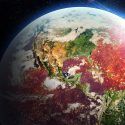One minute, you’re setting up a new space station orbiting Jupiter. The next, you’re plunging right into the middle of a giant, red cyclone of death. What would the storm of all storms look like on the inside? How would it compare to storms back on Earth? And which one of Jupiter’s tremendous forces would strike the lethal blow?
The Great Red Spot is the biggest storm in the Solar System. At about 16,300 km (10,000 mi) wide, it’s large enough to swallow Earth whole. It’s a lot like a hurricane. Only instead of lasting a few weeks, this giant storm has been rampaging for at least 300 years. And instead of forming from warm air, this monstrosity gets its energy from the dense atmosphere of Jupiter.
Fueled by the abundance of the planet’s hydrogen and helium, the Great Red Spot reaches 500 km (310 mi) into its atmosphere. Oops. You should have built your space station a little further away. OK, first, how on Earth would you even get to Jupiter? If you traveled light and followed the route of the Voyager spacecraft, you’d arrive on Jupiter in under 600 days.
But this journey would not be as simple as just pointing yourself at what appears to be a very bright star in the night sky. Roaming the Solar System in a spaceship is a little more complicated than that. You see, the Voyager never intended to land on Jupiter, only pass it on the way to interstellar space. So if you followed Voyager’s path, you’d whip right past your target.
For this to work, you’d need to follow the lead of the Galileo spacecraft launched in 1989. Just like Galileo, you’d swing by Venus and then back around Earth for a little gravity assist. This way, you’d have the right speed to park in Jupiter’s orbit. Only the trip would now take you six years instead of 600 days.
By the time you reached Jupiter’s moon Europa, the planet would appear 22 times larger to you than the full Moon did back on Earth. And you’d still need to get a little closer. Now you’d be mesmerized by the planet’s swirls and stripes. These are colored red, brown and white thanks to the sunlight reflecting off massive clouds made up of ammonia and ammonium sulfide.
Finally, you’d feast your eyes on the Great Red Spot. A giant twirl of the atmosphere rotating counter-clockwise. It looks a lot bigger than you could imagine. Before you even begin your descent into the great red unknown, your life would already be in grave danger. Jupiter’s powerful magnetic field would shower you with intense radiation.
Luckily, you’d be equipped with a highly advanced protective suit. But it wouldn’t be able to protect you from everything. As you approached the storm you’d realize that you made a big mistake in your mission prep. Your plan was to build your space station at the same altitude as the International Space Station, 400 km (248 mi) into Jupiter’s atmosphere.
Except this storm is as deep as 40 Mariana Trenches, so it would swallow you up before you could finish your project. Now it’s too late. You’d be plummetting through the storm. And you’d get your first real glimpse of just how powerful it is. You’d be thrown around at wind speeds of about 400 km/h (250 mph).
To give you a sense of how insanely powerful that would be, hurricanes are ranked into five categories based on strength. A category 1 storm has wind speeds up to 153 km/h (95 mph), strong enough to snap large trees. In the middle, a category 3 hurricane can hit 208 km/h (129 mph). These storms could result in devastating damage, including pulling roofs right off of houses.
Lastly, a category 5 hurricane back on Earth has wind speeds of 252 km/h (157 mph) or higher. That packs enough of a punch to collapse buildings. But that’s still only half as strong as the winds in the Great Red Spot. Thankfully, your body can withstand wind gusts as high as 800 km/h (500 mph). That still doesn’t mean it would be refreshing in any way.
Without the protective face gear, your skin would look as if it was melting straight off your face. So make sure to hold on to that helmet tight. Not that you’d be able to do much else besides staying on a violent downward trajectory at this point. As you were falling into Jupiter, you’d see how clouds around you would change.
First, you’d get a real close-up view of those ammonia and ammonium sulfide clouds you were mesmerized by before. Then you’d pass through clouds made of water, just like the ones on Earth. The temperature and pressure all around you would be changing too. Sadly, none of this would be comfortable for you, especially not at the same time.
Where the atmospheric pressure is similar to that of sea level back on Earth, it would be a very chilly -110 °C (-160 °F). And where the temperature was bearable, the pressure would be eight times greater than what it was back on Earth. The chances of surviving up to this point would be slim. Look no further than the fate suffered by the Galileo probe.
As it descended further and further into Jupiter, it encountered extremely high temperatures. And what do you think happens to a probe in that environment? Yep, it vaporizes. Without a spacesuit strong enough to withstand all that heat and pressure, you’d end up disintegrating just like the probe. Now you’d be one with the gas giant forever.
Sources
- “How Long Does It Take To Get To Mars?”. Daisy Dobrijevic, Nola Taylor Tillman. 2022. space.com.
- “In Jupiter’s Swirling Great Red Spot, NASA Spacecraft Finds Hidden Depths “. 2021. npr.org.
- “Great Red Spot | Facts, Size, & Definition”. 2023. britannica.com.
- “Jupiter’s Great Red Spot Is Surprisingly Deep”. Katrina Miller. 2021. scientificamerican.com.
- “Thunderstorms | Center For Science Education”. 2023. scied.ucar.edu.



























